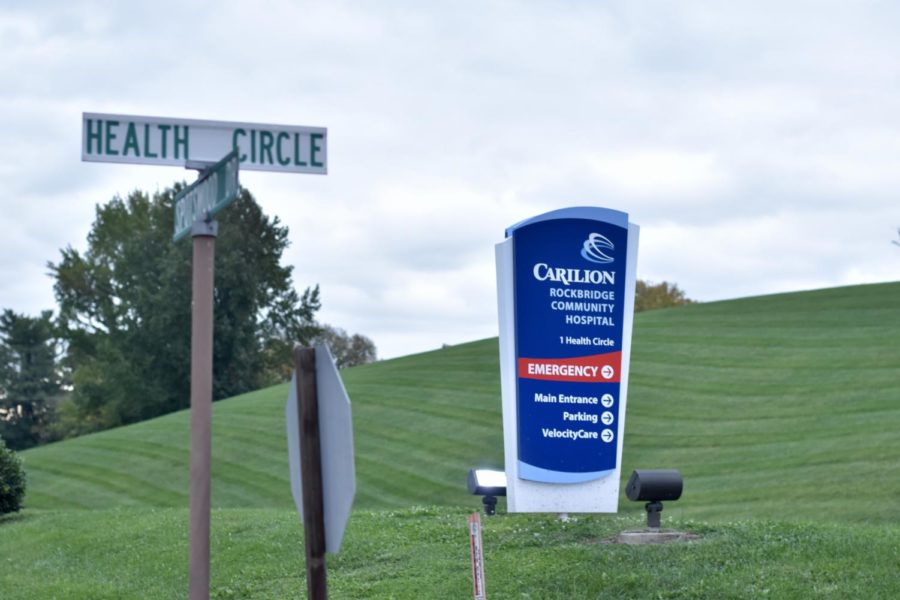Local hospitals, W&L face COVID-19 spike
A surge in COVID-19 cases has strained resources at local hospitals and the student health center.
Staff and resources in local hospitals such as the Carilion Rockbridge Community Hospital have been hamstrung in the wake of a surge in COVID-19 cases, hospitalizations and deaths. Photo by Lilah Kimble, ’23.
October 12, 2021
Rockbridge County hospitals and Washington and Lee University both witnessed a September spike in COVID-19 cases. But the disparity in vaccination rates between the local and on-campus communities has created two different scenarios.
On a local level, the Carilion Clinic, which serves Lexington and Rockbridge County, reported that over 80% of the hospitalizations in their network involved unvaccinated individuals.
From Sept. 1 to Sept. 30, the clinic recorded 498 hospitalizations throughout western Virginia.
The increase in hospitalizations has strained hospital staff, a representative from Carilion Rockbridge Community Hospital said.
Hospitals like Velocity Care Lexington have closed down for a weekend due to staffing shortages, and local hospitals have not had the capacity to care for non-COVID-19 emergencies.
“We are a relatively small hospital, and before COVID-19, it would not be unusual for our hospital to run up against full capacity,” said Greg Madsen, vice president of Carilion Rockbridge Community Hospital. “When the first wave of COVID hit, it certainly was a stressor for all hospitals. What’s notable is that the second wave were much sicker patients that required more resources and staff attention.”
The CDC reported that 61.4% of Virginia’s population was vaccinated as of Oct. 9.
Washington and Lee faces a very different problem: with a high vaccination rate of more than 95%, breakthrough cases, or cases with vaccinated individuals, have become more prevalent.
The university’s COVID-19 committee changed the COVID-19 environment level from yellow-low to yellow-middle Sept. 16.
The university’s recent spike in cases led the committee to announce stricter masking guidelines and emphasize current health guidelines.
“Every county in the state right now is considered to be at a high transmission level,” director of student health and counseling Dr. Jane Horton said. “That’s true across most of the U.S., and it’s also true locally. It’s had an impact on the local healthcare system in terms of hospital bed availability, ICU bed availability and staff availability to manage not just COVID-19, but other health conditions that need to be dealt with immediately.”
At Washington and Lee, the rise in cases and close contacts created additional stresses on the Student Health Center, while student social life seems to be returning to normal.
“We are short-staffed by nurses already, and we are trying to hire additional nursing staff but there’s a nursing shortage everywhere,” Horton said. “It’s been impacting us in terms of managing that workload, but we have not had to shut down or stop what we’re here to do.”
To compensate for the staff shortage, nurses are working longer shifts. The rise in cases involves increased contact tracing as well.
Horton said the loosening of COVID-19 restrictions has strained staff further.
“Part of the problem is that because there are really no restrictions right now on activities and gatherings,” Horton said. “People are doing things that are getting themselves sick, injured, intoxicated and impaired, and the volume of those visits, which is our routine care, is back up to normal. Then, we have all the COVID-19 stuff on top of it.”
Horton noted that current COVID-19 cases within the campus community have mild to moderate symptoms and are less severe compared to last year.
“The vaccine is not preventing infection as well as we hoped it would, but it is certainly reducing the risk of severe infection, and we’ve had nobody who needed to be hospitalized,” Horton said.
The spike in cases at Washington and Lee has decreased significantly since September. As of Oct. 8, there are 8 active cases.
The same trend can be seen on a local level. Cases began to level off starting in late September. Both Horton and Madsen still urged community members to stay vigilant and maintain health protocols.
“We have seen some levelling off, but it doesn’t mean we’re out of the woods,” Madsen said. “There’s a cautious optimism, but our guard remains up. We always want to make sure we’re prepared for the worst, but hope for the best.”



